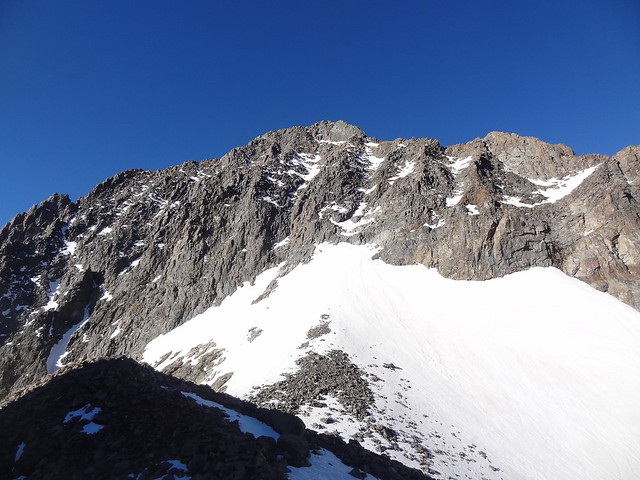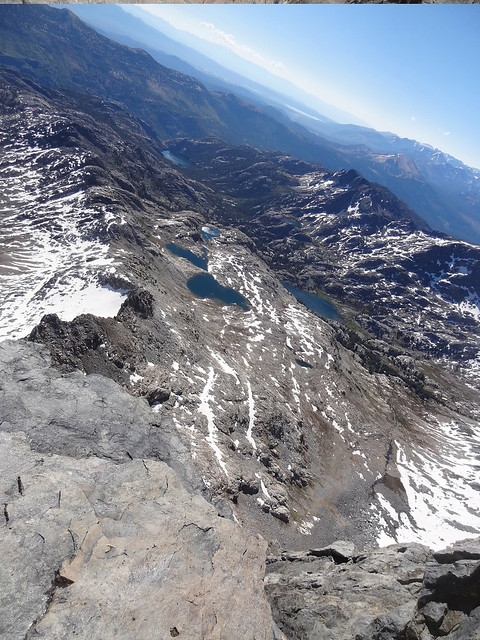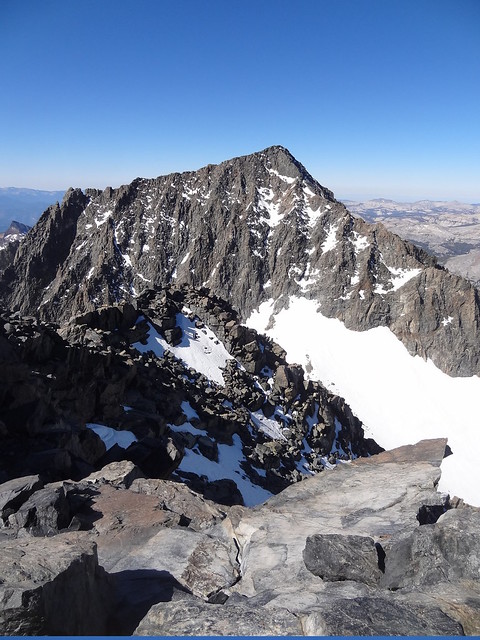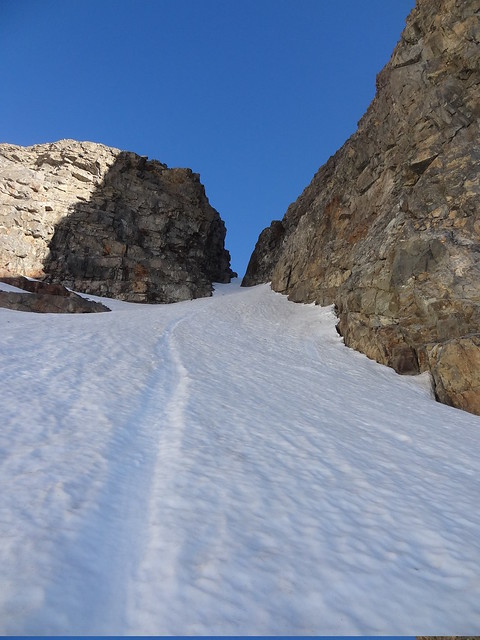My interest in Banner Peak and Mt. Ritter began when I encountered them while hiking the John Muir Trail in August 2014. Immortalized by Ansel Adams, the 2 mountains framed by Garnet Lake and Thousand Island Lake are well known and frequently climbed.

I snagged permits for Ediza Lake several months ago, with an intention to climb both Ritter and Banner via their scrambling routes from the Ritter/Banner saddle.
The hardest problem in High Sierra climbing is balancing a technology job in Silicon Valley at the same time. Getting to the eastern Sierra takes forever from the Bay Area. I hate to drive that distance twice over a weekend and it prevents deeper exploration of backcountry peaks. Fortunately, things had worked out so that Banner Peak was the first in a series of adventures as I drove up along the west coast from the Bay to Whistler, BC. I left the Bay Area on Friday night and drove into Hodgdon Meadows campground at midnight. The rest of the crew was already there. After a decent sleep under pines, we packed up and drove to the Mammoth Lakes Visitor Center to pick up the permit. It was a ridiculously hot day and it seemed like the uphill wasn’t going to be fun. On the other hand, I was carrying new glacier glasses and was excited to try them on!
The Mammoth Ski Area and Devil’s Postpile were very crowded and we had to wait for 2 shuttles before we could get on. With several pointy things on our packs, people gave us a wide berth. Taking the shuttle brought back not so fond memories of the JMT, when we had emerged out of Ansel Adams wilderness after a 17-mile day followed by a boring 14-mile day. Fortunately the River Trail is much nicer than the JMT as it winds its way up the Middle Fork San Joaquin.
After all these shenanigans to get to the trailhead, we started hiking at 12:54pm. The hot weather had led to typical Sierra afternoon clouds and there was occasional thunder as we began the hike. Fortunately the winds were carrying the clouds away from us. After about 2 miles the trail heads west to follow Shadow Creek and begins the 700ft ascent to the lake outlet. Shadow Creek was in full flow, creating remarkable waterfalls down quality granite.
Although Banner and Ritter require crampons and ice axe, they are not very technical. The best footwear is mid-weight hikers which are solid enough to accept strap-on crampons. Unfortunately I don’t have something like that, so I wore trail runners and paid the penalty of carrying 3 season mountaineering boots. Still, I’d have hated to do the 8mi approach in mountaineering boots in such hot weather and I paid the price willingly.
We stopped for lunch near the Shadow Lake inlet and enjoyed Jamie’s summer sausage. Earl was having some trouble keeping up and the mosquitoes got to work on us until he caught up. Here I made a mistake and started heading south on the JMT, fortunately realizing within a few hundred feet when the trail started downhill. After following the JMT for a short stretch, with the picture of the missing hiker still present at the post, we branched off to the Ediza Lake trail. This is great hiking with several cascades and tree cover cooling things down. Views of the Ritter range peek through under brilliant blue skies. Yellow glacier glasses also tend to pop blues, making it even nicer!
We reached Ediza Lake around 4pm and debated if we should cross the shorter talus or the longer trail. The trail won and we made it to the west side quickly. There were already several tents pitched here. At this point we still had several hours of daylight and most of us were feeling good. We decided to put in another 2miles and 1000ft of effort to go higher up the valley leading to Ritter and Banner. This allowed us to
1) Be above the treeline with nicer views and more solitude. 2) Get a good idea of conditions on the route. 3) Not have to deal with finding the way up the valley in the dark the next morning. 4) Shave some elevation off the next day which was going to be much longer.
Our efforts were rewarded with an incredible waterfall!


Over all, I highly recommend the higher elevation campsite. No mosquitoes, solitude and great views. Around 10200 feet there are some reasonably flat spots about 200feet east of the small creek. This is right next to a series of big, flat boulders that shape the creek. After a ramen and scrambled eggs and bacon dinner, we prepped the packs for the next day and spent some time enjoying the absolutely stunning scenery. A huge cell had developed further down the valley and the setting sun was throwing up every shade of orange on it. I also spent some time walking Jamie through ice-axe and crampon fundamentals, since she was the only one in the group with no prior experience. Ed had decided not to attempt the summit so he wouldn’t make his knee any worse.

The next day we started moving at 5:10am. Already the weather was very mellow. In fact it hadn’t even reached freezing at night. Within a quarter mile it was time to put on crampons to deal with the hard snowfields lower down the valley. Arun found out that his rental crampons were not going to fit his shoes and had to bow out too. Earl would turn back after some time as he was having trouble keeping up again.
Conditions were good and the rest of us - Dawn, Jamie, Michal and I - made good progress to the true snowfield. There was some snow melting already and slush was starting to show up in places. As you gain the snowfield you are treated to the first views of remote Iceberg Lake. The Minarets Loop has long been on my list and I should get to it soon. I’d like to reach a fitness level that would let me do it in 2 days while still enjoying it before I attempt it.
The wind picks up as soon as you are on the snowfield and once you enter Banner’s shadow, things get really chilly. The couloir leading up to the the saddle is intimidating, but can’t be more than 50 degrees at the steepest. Stay to the right so avoid occasional rockfall. We gained the saddle some time after 7. There was still plenty of snow on Ritter’s North face and the saddle. The glacier on the west led directly to frozen Lake Catherine. There was no one in the mountains yet except us.

We left our crampons at the saddle and started up the talus slog that is Banner’s west face. It is unstable, tricky, and this early in the season had dangerously icy blocks as we went higher up. There were cairns marking the way occasionally, but we’d often have to take detours to avoid the ice. Fortunately the route finding is straightforward. Stay low and head towards the west ridge. It is important though to not actually get to the ridge. With some occasional class 3 climbing we were able to get close to the summit fairly quickly, but then had a decision to make. Should we get to the west ridge or was there a direct way to the summit?
I decided to head for the ridge and that culminated in two truly scary moments. One was mantling onto a icy rock with a fair amount of exposure. That allowed me to gain the ridge, but as I found out, that was too far. Although you can ride the ridge to get near the summit (close enough that you can hear and see your team which has stumbled upon the correct path while you’ve been trying to kill yourself!), there is a gendarme that blocks the way and I had to do another bit of tricky traversing (grumble, mountaineering boots, grumble) to get back on route. After an unnerving few minutes, I was finally on the summit at 9:15am.
The views from Banner Peak are astounding. Remote landscapes across the Sierra and Mono county merge with familiar landmarks. Thousand Island and Garnet Lakes are just a steep drop away, Donohue pass is up north, Mono Lake twinkles farther out and Iceberg Lake stands alone among the Minarets. To the west, Ansel Adams wilderness stretches out. Down south the peaks of the High Sierra go on forever and while I’m no great peak identifier yet, just knowing that Mt. Brewer and Whitney and others were out there adds a sense of grandeur to the adventure.




The elephant in the room is of course Mt. Ritter. It was painfull obvious that we wouldn’t be able to climb it. Going up Banner had been slow and descending would be even slower due to the unstable rock. Facing over 13mi of hiking from the summit to the car, the prospect of hiking up another 1000ft of unstable rock was unappealing even if we had had the time.
After signing the register Michal headed down while the rest of us enjoyed the summit a little longer.
The way down was uneventful except for the occasional pile of rocks someone would send tumbling down. If you are experienced enough in the Sierra to attempt Banner, you should already be aware of spacing people out and staying out of fall lines. Don’t forget a helmet! Back at the saddle we noticed a trio halfway up Ritter. An enterprising lone skier made it to the saddle from Lake Catherine and skied down. We put the crampons back on and downclimbed the couloir. This was not fun at all. The snow was sticky and unstable and the going was slow. Slush and dangerous potholing on the lower snowfield was followed by a talus descent until we finally arrived back to camp around 12:30.
Ed and Ankur had hiked on ahead so they could take it slow, while Earl was waiting for us and left as we arrived. Everyone was exhausted, but there was enough adrenalin to keep things in motion and we packed up and started hiking out by 1pm.
The descent was brutal on the knees and took forever. We took the talus side of Ediza Lake, crossed the outlet via a series of very delicate steps, and trundled quickly down the rest of the trail. I felt fairly empty inside, so imagine my surprise when a hiker going up remarked that I looked really fresh. The more adventures you do the more abuse your body seems to withstand, but the mind doesn’t always calibrate itself correctly, especially when the weather is bad or the stomach is rumbling.
Tackling the 300 feet of uphill specially reserved for the very end of the trail we reached Agnew meadows after 11hr and 39min of being on the move for the most part. After a shuttle dance we got to the cars around 6pm.
After a quick dinner at Pita Pit, everyone else left to drive back to the Bay Area. I was heading to Reno, for the first of several nights not spent in my own bed. I stopped near Mono Lake to catch sunset, before driving the rest of the way along beautiful 395 (the second time within a month) and collapsed at the Nugget around 10:30.
The case of the missing bear canister
Visitors to the Devil’s Postpile area are required to park vehicles near the Mammoth Ski Area and take the shuttle. I had a fair amount of food in the car since I was going on a long trip, but the ranger at the permit station said I should avoid leaving it in the car. I also had a spare bear canister that I was to loan to a friend. So I figured I’d just put the food in there and put the canister in some trees close to the car. Some asshat stole the canister! It can’t have been a bear since the canister was jammed in among some branches so it wouldn’t roll and a bear would have a difficult time opening it and would have given up. I couldn’t believe that someone could steal a bear canister out there!
Hiking stats according to Suunto Core (includes breaks)
Trip date: June 13-14, 2015
- June 13 - start 12:54. Car to camp: 6hr 15min 36sec
- Peak elevation: 3044m
- Ascent: 617m, avg 6m/min
Descent: 115m 5m/min
June 14 - start 5:10. Camp to summit to car: 11hr 38min 58sec
Peak elevation: 3871m
Ascent: 954m avg 7m/min
Descent: 1457m 9m/min








